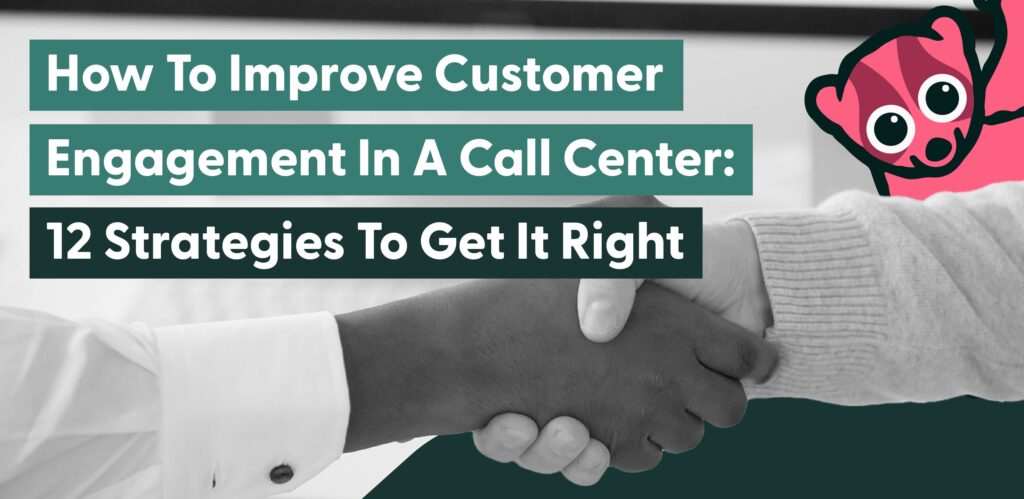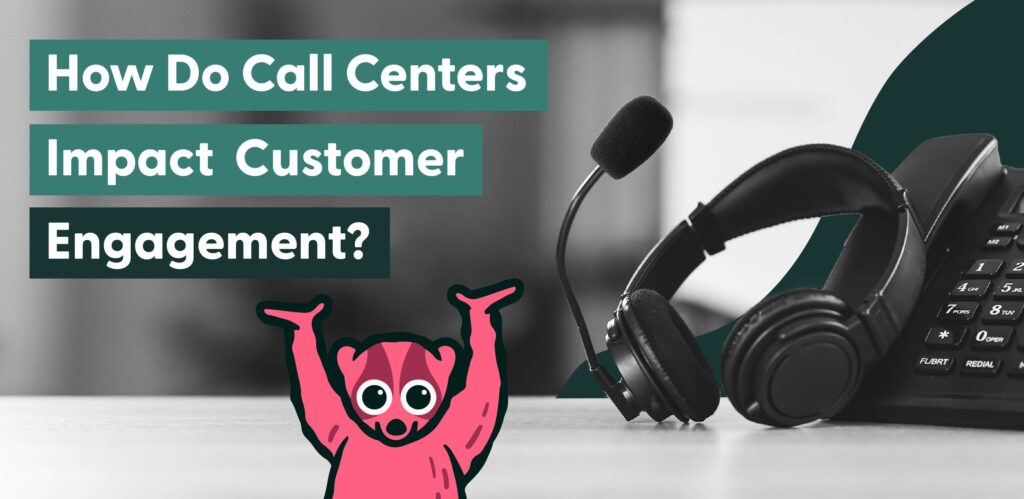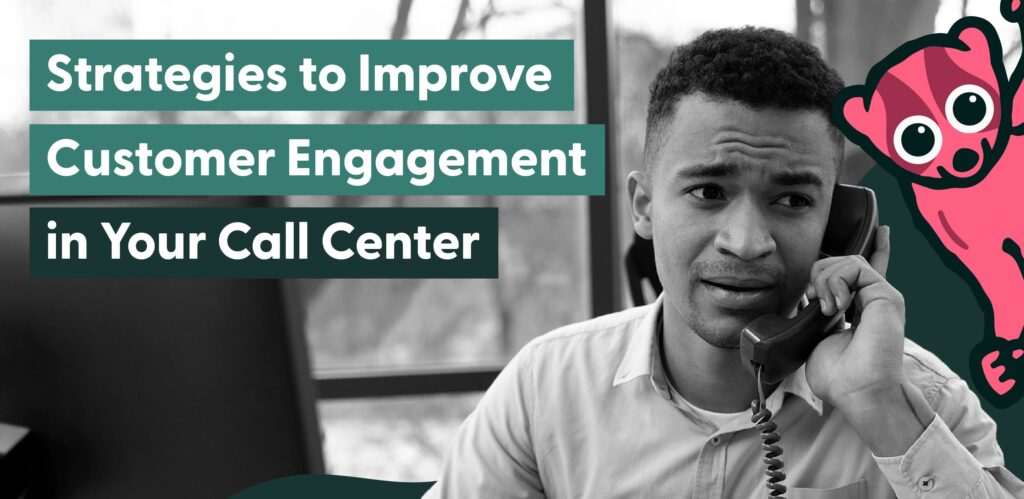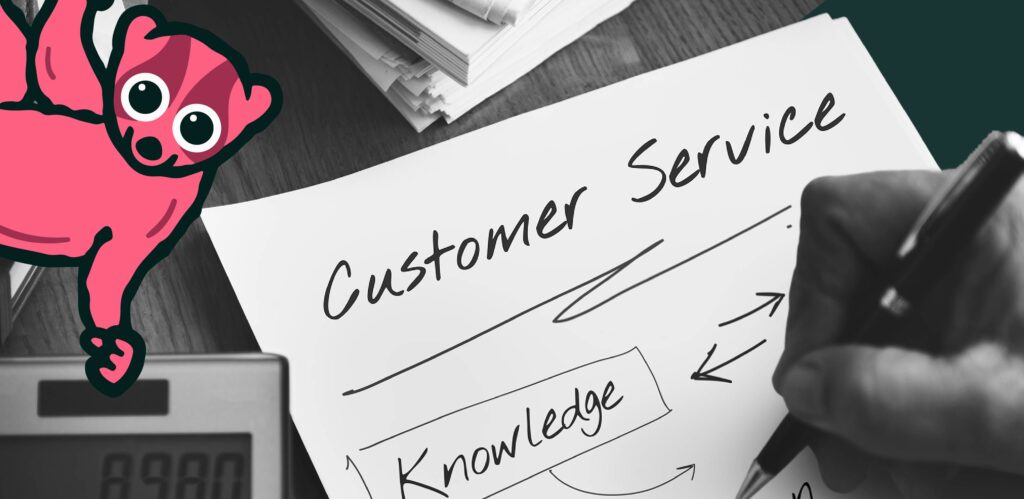
The cost of acquiring new customers is far higher than retaining existing ones. In fact, the average customer acquisition cost (CAC) is around $606 per customer. Additionally, churn costs U.S. businesses $168 billion each year.
The average cost to simply retain a customer is only around $200. And your top 10% most loyal customers will spend twice as much as other customers.
One way to ensure you retain your customers, earn their loyalty, and reduce churn is to improve customer engagement within your call center.
In this guide, we’ll walk you through what customer engagement is and provide 12 strategies that you can use to drive better engagement in your contact center.
What Is Customer Engagement?

Customer engagement refers to the communications your business uses to build relationships with customers. It involves creating meaningful, personalized, and positive interactions with your customers that foster trust, loyalty, and satisfaction.
Rather than simply resolving issues or answering questions, customer engagement focuses on building a connection that encourages ongoing interaction and strengthens customer relationships with your brand.
Customer engagement involves:
- Ensuring every customer interaction is met with active listening and responding empathetically and attentively to ensure the customer feels heard and understood.
- Understanding and addressing customer needs, answering questions, and solving problems quickly. It’s also about ensuring customers feel valued and heard when they contact your call center.
Why Is Customer Engagement Important?
Now that you know what customer engagement is, let’s take a closer look at why it matters if you’re running a contact center:
✅ Improve the customer’s perception of your company
When your call center agents engage with customers in a helpful and empathetic way, they leave with a positive impression of your brand. After positive customer interactions, customers are more likely to see a company as reliable, caring, and attentive to their needs, naturally enhancing your brand’s reputation.
✅ Increase customer retention
Engaged customers are more likely to remain loyal to your business. When they feel their concerns are understood and resolved quickly, they are more inclined to continue doing business with you, leading to higher retention rates for your company.
✅ Enhance the customer experience (CX) and maximize revenue
Did you know that 84% of companies that work to improve their customer experience notice an uplift in revenue? Effective customer engagement within your contact center helps create a smoother and more satisfying customer experience, increasing your revenue as a result.
Like what you’re reading? Get the latest news and product updates delivered to you in our newsletter.
How Do Call Centers Impact Customer Engagement?

Call centers aren’t the only business function that impacts customer engagement, but they can strongly influence it.
As one of the primary points of contact for many customers, call centers often serve as the face of your company, playing a crucial role in shaping how customers perceive your business.
For many customers, a call center is their first interaction with a company, so how well your agents handle this first impression significantly impacts the customer’s perception. A friendly, efficient, and empathetic response sets a positive tone, making customers feel valued.
This is why it’s essential that the customer feels positive after interacting with your contact center; it’s how you drive better customer engagement.
Strategies to Improve Customer Engagement in Your Call Center

Let’s take a closer look at how to improve customer engagement in a call center with some effective strategies:
1. Analyze customer data
Customer engagement analytics refers to the process of collecting, analyzing, and interpreting data about customer interactions to understand how effectively your company is engaging with them.
This data-driven approach helps businesses measure and improve the quality of customer interactions across all their communication channels, including calls, live chat, and emails.
The goal is to gain actionable insights into customer behavior, preferences, and satisfaction to enhance engagement, improve experiences, and increase customer loyalty.
Using a conversation intelligence platform can help you understand your customers and address their needs to drive better engagement and satisfaction.
💡 The Best Way to Understand Customer Needs
Loris is a conversation intelligence platform that analyzes every customer interaction in your contact center to help you identify and answer customer needs more effectively.
2. Manage customer demand
Customers want their problems attended to immediately when they contact your call center, with over 72% of customers demanding immediate service.
One way to meet customer demands is to implement omnichannel support, including email, chat bots, calls, and live chat.. This provides customers various communication options, helping to distribute demand across channels. Nearly 80% of customers prefer omnichannel strategies due to the seamless communication experience they provide.

Omnichannel support ensures customers can choose their preferred contact method and reduces pressure on phone lines and agents. It enhances customer engagement by offering more convenient ways to interact with your company.
3. Make an excellent first impression
Call center managers need to ensure that customer service agents make a good first impression across all channels, as this initial impression can set the tone for the remainder of the customer experience.

Agents can ensure they make an excellent first impression by doing the following:
👍 Answer promptly and professionally: Responding quickly and with a positive tone sets the stage for a productive interaction. A warm greeting and polite language can make customers feel valued from the start.
👍 Active listening: Allowing the customer to explain their issue without interrupting shows respect and interest in their concern. Active listening helps build rapport and makes the customer feel heard and understood.
👍 Be empathetic and friendly: Agents should express empathy, especially if the customer is frustrated or upset. Showing that they care about the customer’s feelings creates a positive connection.
👍 Personalize the experience: Addressing the customer by their name helps personalize the interaction, making it feel more tailored to the individual. In fact, 71% of consumers expect companies to deliver personalized interactions, and 76% of customers get frustrated when this doesn’t happen.
👍 Use positive language: Agents should use positive language while interacting with customers via your support channels. Positive language is about focusing on what you can do to resolve customer issues rather than what you can’t do about them.
4. Consult your customer service team
Your contact center agents often have better insight into processes that aren’t working or pain points that aren’t being addressed than other people in your business might have because they deal directly with your customers.
This makes it important to gather feedback from every contact center agent on your team to determine how to improve customer engagement.

It’s a good idea to hold regular feedback sessions where you find out from your agents what could be improved and then share this information with your entire company so that improvements can be made.
5. Leverage call scheduling
Call scheduling is a technology that allows customers contacting your call center to choose whether they’d like to wait to speak to an agent or schedule a callback. This gives customers a say in their journey with your business.

By leveraging call scheduling, you can:
✔️ Reduce wait times, improving the overall customer experience.
✔️ Increase convenience for your customers, showing that your company values your customer’s time. 73% of consumers feel that brands valuing their time is a sign of good customer service.
✔️ Reduce the number of abandoned calls, keeping the interaction going.
✔️ Improve agent performance, further boosting customer engagement.
6. Use sentiment analysis to acknowledge customer concerns
Sentiment analysis is when you analyze how a customer feels and their mood through the words they use and display this information to agents in real-time.
If a customer expresses an emotion and feels like the call center agent doesn’t understand it, it can add tension to the conversation.
Sentiment analysis helps agents understand how customers feel during the interaction so that they can respond accordingly and improve engagement.
💡 The Best Sentiment Analysis Platform for Your Contact Center
Loris provides agents with sentiment analysis during live interactions with customers as well as in post-call analysis, giving your teams the tools they need to understand and respond to customers in the best possible way.
7. Solicit customer feedback
Customers are typically happy to give you feedback on how you can serve them better and provide them with improved solutions. You can gather feedback through:
🗣 Surveys and feedback forms: Regularly ask customers for feedback on their experience using post-call surveys or email follow-ups to gain insights. This is a good way to show customers that their opinions matter to your business.
🗣 Net promoter score (NPS) and customer satisfaction (CSAT): Track customer satisfaction using NPS and CSAT scores to identify areas of improvement. Low scores may indicate a need for better customer engagement strategies, and acting on this feedback can lead to positive changes.

You should take customer feedback seriously, use it to identify what’s causing their frustration, and then find ways to avoid these problems in the future.
For example, customers may express frustration over how often they’ve had to contact your call center to resolve an issue. However, they may have valuable ideas about how you can improve your customer service so that this problem is avoided for future customers.
8. Create simple customer experiences
Over 74% of consumers prefer accessing customer service through multiple channels. Customers expect seamless experiences across all your customer service channels, so you should aim for a unified approach.
One solution is using a customer relationship management (CRM) platform that allows your agents to access customer history, preferences, and previous interactions.

You can also use artificial intelligence (AI) chatbots to simplify customer support, freeing up your agents to deal with more complex requests. Customer satisfaction increases by 64% in contact centers offering real-time assistance through tools like chatbots.
9. Keep your agents happy
Longer-tenured, more experienced agents bring more expertise and knowledge to customer interactions. This means that improving employee retention directly impacts the quality of your customer service and, in turn, customer engagement.
You need to find ways to increase workplace satisfaction, as happy employees are more likely to stay with your company. In fact, agent retention rates improve by 30 to 40% when you keep your employees satisfied.

One way you can ensure your agents’ happiness is to make sure that they feel your quality assurance (QA) process is fair and transparent and provide them with the tools they need to resolve customer complaints efficiently, like extensive knowledge bases.
10. Provide contact center agents with self-directed learning tools
Call center agent training and coaching is crucial for improving customer engagement in your contact center. Well-trained agents are better equipped to handle customer inquiries, resolve issues efficiently, and provide a positive, personalized experience.
For example, training agents to actively listen to customers allows them to better understand their needs, respond appropriately, foster a deeper connection, and make customers feel heard and valued.
While you should hold regular, in-person coaching sessions, providing agents with self-directed learning tools gives them easy access to courses, tests, and videos that can continuously grow their skills.

Self-directed learning empowers agents to take charge of their learning and development, enhancing their ability to deliver high-quality service and further their careers—another way to keep employees happy.
11. Foster a proactive approach
Another strategy to improve customer engagement is being proactive about your customer service. Follow up with customers with personalized communication via phone or email to ensure they’re satisfied with the resolution to their problem.
Additionally, you can use conversation intelligence to identify the common issues that customers contact you about. Then, you can use these insights to create helpful tips and frequently asked questions (FAQs) documentation that customers can use to self-serve.

Conversation intelligence platforms like Loris also allow you to detect emerging issues as they arise so that you can address them proactively to avoid customer dissatisfaction.
For example, if your conversation intelligence platform provides insight that your customers are complaining about your systems being down, you can be proactive and send push notifications to your customers stating that you’re working on the problem and estimating the time that services will be restored.
12. Enhance your problem-resolution speed
Customers will become frustrated with your service when their problems aren’t resolved on the first call. Over 90% of customers rate quick resolution of their issues as a top priority when contacting a call center.
For this reason, monitoring and improving your first call resolution rate (FCR) is essential. Your FCR is the percentage of customer inquiries or issues resolved during the first interaction with your call center without needing follow-up calls or escalations. It’s a key performance metric that measures how effectively a call center addresses customer needs in a single interaction.
When a problem is solved during the first contact, customers are more likely to feel satisfied with the service you’ve provided. A high FCR rate minimizes the need for repeat contacts, reducing frustration and ensuring a smoother experience.

Resolving issues on the first call saves customers the hassle of contacting your call center again, leading to a more positive experience and stronger engagement.
Here are some ways you can improve your FCR in your contact center:
💡 Give agents decision-making power: Equip your agents with the authority to make decisions such as issuing refunds, providing discounts, or solving problems without seeking supervisor approval.
💡 Develop troubleshooting guides: Ensure your agents have access to extensive knowledge bases and easy-to-access troubleshooting scripts for frequently encountered issues.
💡 Train agents to ask probing questions: Provide your agents with training on how to ask clarifying questions to fully understand the issue before attempting to provide a solution to the customer. This reduces the risk of miscommunication or incomplete resolutions.
The Best Platform for Call Center Customer Engagement
Customer churn and acquisition costs are far higher than the costs of retaining customers. However, you can improve customer retention by following the above customer engagement strategies.
Loris is an AI-powered conversation intelligence platform that provides deep insights into your customers’ needs and pain points based on the interactions your contact center receives. Conversation intelligence can help you give your customers the service that turns them into loyal advocates for your brand.
Our platform analyzes every customer interaction in your contact center to provide rich, accurate, actionable insights that you can use to improve your customer experience and your business as a whole.
Speak to a Loris expert today to learn more about how our platform can help you drive better customer engagement in your contact center.
